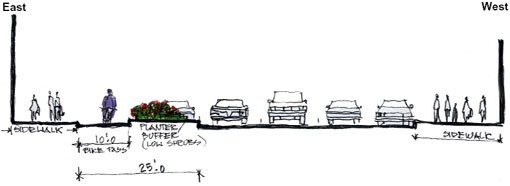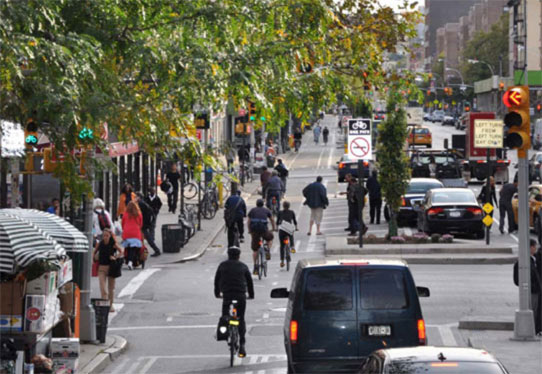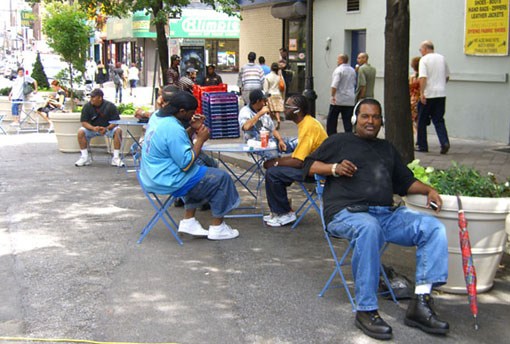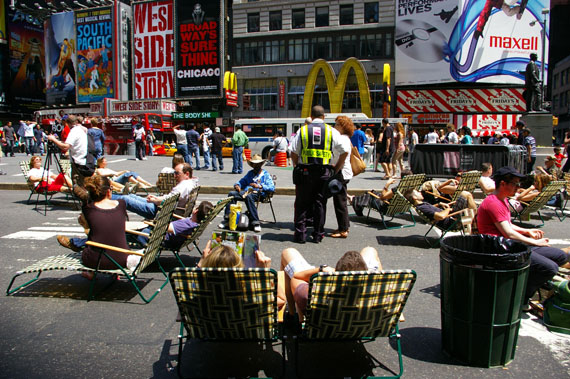Today is Ryan Russo's first day as Oakland DOT commissioner following 14 eventful years at NYC DOT. Up until this March, for as long as Streetsblog had been publishing, Russo was working to make NYC streets better for walking and biking, most recently as DOT's deputy commissioner for planning.
Few people have been so closely involved in the transformation of the city's streets over such a long period of time. So between his last day at NYC DOT and his move to the West Coast, I caught up with Russo to get an insider's perspective on more than a dozen years of change to NYC streets.

In this installment, we review some of the greatest hits from his early days at DOT and the blossoming of public space and bicycle projects under Mayor Michael Bloomberg's PlaNYC initiative. In part two, coming up tomorrow, we discuss current issues concerning the development of NYC's bike network and pedestrian safety improvements. The interview has been edited for length and clarity.
What did DOT hire you to do in 2003?
It was a newly-created position of downtown Brooklyn transportation coordinator. The city wanted to do this upzoning around and in downtown Brooklyn, but there were really strained relations between the neighboring communities and DOT around street management, traffic management, livability, quality of life. It was a deal between EDC, City Planning, and DOT to fund a position that would focus on strengthening those relationships and bringing a multi-modal perspective.
They called it the "downtown Brooklyn transportation czar." But I quickly learned there are no czars in local government and that really, the way to be effective was to collaborate internally with the people [at DOT and other agencies] in order to highlight the opportunities that were there.
What were these opportunities?
There were a lot of fun things that we did that ended up being models for DOT going forward. One was the Tillary Street two-way protected side path leading to the Brooklyn Bridge, connecting Clinton to Adams Street. That was in 2005. A lot of folks took Clinton -- there wasn't a lot [of bike infrastructure] in the core of downtown Brooklyn. It was a back door to the Brooklyn Bridge, but those last two blocks were really intense and harrowing.
And that project really illustrates the theme. That required a lot of collaboration. I remember the Brooklyn borough commissioner at the time, Lori Ardito, and I were discovering late in the planning process that the drain at Cadman Plaza East and Tillary Street was the one where Sanitation did its major snow melting operations for big snow storms, and that they had concerns with the proposed design.
There's so much snow on the paths and streets when you get big snows, that basically they plow it all, close half of Tillary Street, pile it up in the area, and then have a big dump truck with a hot coil in it, and use front end loaders and dump it in there, and then it melts and goes down a drain.
They had to find a different drain.
No, they used the same drain. It's two blocks. One and a half of the blocks were concrete jersey barriers, and half a block was what we call quick curb. The reason for that was to give Sanitation the access to that drain.
Then Willoughby Plaza was another. I remember that feeling like a breakthrough, in that DOT was showing this level of flexibility and nimbleness that we hadn't really come to expect.
There was precedence before my time of the operational toolkit [DOT's techniques and materials for making low-cost street design changes]. Times Square had a little bit that was done, Herald Square had a big pedestrian project done, the Grand Concourse -- they were projects led by Randy Wade, someone who recently left the department after a lot of accomplishment and deserves a shout-out.
There was a template for us. And then in the summer of 2006, with the internal development of PlaNYC, which was coming out in spring of 2007, there was this policy decision to get more serious -- that came from City Hall, Mayor Bloomberg and Dan Doctoroff -- to do 200 miles of bike lanes in three years, and four pedestrian plazas -- public spaces -- a year.
We were looking for opportunities and building up our capacity at that moment. And that particular opportunity did come from our deputy commissioner at the time, serving jury duty, sitting in the juror waiting room looking out over Adams Street, and seeing a huge volume of pedestrians and a low traffic volume, and good retail, and that sort of thing. That was where that opportunity came from. We reached out to the MetroTech BID, and started a conversation, and one thing led to another.
And that's when I was tapped out of the downtown Brooklyn role, and asked to run the new, growing bike/ped office.
So you've gotten your feet wet in downtown Brooklyn, and then you take on a citywide scope under PlaNYC?
Exactly. When City Hall came with that policy shift, it was, "We need someone to build [the bike/ped program] up. It's getting resources. We've got new commitments around bike parking, bike lanes, pedestrian projects." It's a citywide purview, and the idea was to build the bike network out quickly and do a lot more for pedestrians.
What was the decision-making like in terms of pursuing these changes via the operational toolkit, as opposed to the capital process? Was it obvious that's the way it needed to be done, or was there some debate?
It was more obvious because while at the time, New York City DOT had a somewhat poor reputation around these livable streets-type initiatives, there were actually a lot of concepts being approved on the drawing board internally at DOT. The analysis done, the planning done, and the concepts approved, they would just get bogged down in the complexities, as a capital project, of the budgeting, utility coordination, the stakeholder coordination, all those things. There were a lot of things that weren't coming to fruition.
Can you give me a few examples?
The Astor/Cooper Plaza area was one that was on the drawing board and supported. The East Houston Street pedestrian project was another. There were some plans for Herald Square. There was the Williamsburg bus plaza, where the Williamsburg Bridge comes down. There were others, too. [Editor's note: Several of these capital projects only just wrapped up in the past year.]
There was a real push for action as part of PlaNYC. They thought there were only three years left in the second term of the Bloomberg administration, and wanted to really plant the seeds of a policy change.
The thing I would say is once you figure out how to get it in the ground so quickly, it's incredibly rewarding, and so you keep trying to find ways to get it done.
At what point was DOT internally comfortable with the idea of the big Broadway redesign, and doing such a high-profile transfer of space from motor vehicles to pedestrians in the heart of Midtown?
Broadway, because of its diagonal nature across the grid, was a place of consensus between planners and engineers. There was always a consensus that more could be done. We had a couple big projects that we did in 2008, sort of as preludes to the more well-known changes in Times Square and Herald Square in 2009. We did the Madison Square redesign, which de-emphasized Broadway's role at Fifth Avenue, the Flatiron area. We took a couple lanes out, and did a public space between 42nd and 35th.
When you get to implementation day, what's running through your mind when you actually pull the trigger? That first period where people are just getting used to it.
It can be really nerve-wracking. One of the things I've learned is that people really respond to the cues of design -- markings and geometries -- but if they're used to a place, when you change it, they behave the old way for a while.
An old colleague said, "Give it 11 days." We had it down to a science, which was 11 days. You see people drive on the re-designed street the old way, and you have some doubt, and say, "Is this going to work?" There's some tension to it, but we learn so much doing it over and over again, and the rate at which we've had to scramble and make adjustments after we do something has actually gone down over time. We get it more right the initial time more frequently.
I want to backtrack a bit and talk about the arrival of protected bike lanes in New York City. What was the discussion like inside DOT about deploying these new designs?
I think [former DOT Commissioner] Janette [Sadik-Khan] really had a vision for it, and it was really just, "Why can't we have bike lanes that are more like European cities' bike lanes?" Once that was the ask, our task was to look and see: Where do we think it could make sense? How would we do it in the New York context?
We'd just wrapped up the 2006 bicycle fatality and severe injury study pretty recently, and at that time, nine out of every 10 of cyclist fatalities occurred at intersections. Our biggest concern was the feeling of protection would be extremely valuable and powerful, and could get more people on bikes, but there's the feeling of safety and then there's the actual safety at the intersections. If there was a wall of parked box trucks or SUVs, New Yorkers wearing dark clothes at night, and then you had turns at intersections that were unmanaged. So, our big task was to make sure that it actually was safe for cyclists, and that we didn't have that negative problem.
When did you know that was working? Was there an "A-ha!" moment?
For Ninth Avenue, I was out making observations, it was winter [2007], and a mom came with a 7-year-old on her own bicycle, and turned on from a side street, and went biking down Ninth Avenue. And I stood up on a scaffold and snapped a photo. The idea that someone who's seven or eight years old would ride their own bicycle on an avenue in Manhattan -- it was an outlandish concept. The fact that someone had done that, that quickly, made me realize that people were going to respond to this.
Nationally we write about how engineers feel like they don't have permission for this type of design, because it hasn't been embraced by AASHTO. But it sounds like when your department leadership wants to do it, those obstacles melt away. Is that fair to say? Was there resistance here?
One of the things that may not be as well understood is that there's a history of relatively independent thinking at the New York City Department of Transportation. That was the culture. New York City, because of its age and its density and complexity, is not built to the specifications of all of those design guidelines. The exceptions are out there everywhere. So much of it doesn't meet those standards.

There's the section of the state vehicle and traffic law that basically says cities over one million [residents] have a bit of their own independence on a lot of these issues. There's a legal ground to that independent thinking.
The question we had with these manuals -- whether it's the AASHTO guide to development of bicycle facilities, the Green Book, the Manual on Uniform Traffic Control Devices -- was [about] stuff that's not in there. Was omission the same as prohibition, or did you have the design flexibility to use expertise and judgment to do this? I think the culture was the latter.
The key is to treat design guidance as guidance and not standards. The whole point of standards is that a stop sign should look like a stop sign in the whole country. Everyone should use yellow lines to separate two-way traffic, if you're going to use lines. We shouldn't change it to green. We shouldn't put up a blue stop sign.
The uniformity of the MUTCD, that "U" is important, but it doesn't mean that you can't fill in the blanks and think about your specific context. When we referred to those documents, we would ask ourselves, "If it says you shouldn't do something, what was the reason why? Could you mitigate that?"
The AASHTO guide for bike facilities was the perfect example. It said, "You shall not put a bike lane on the opposite side of a turn lane." You can't put a bike lane to the right of a right-turn lane or to the left of a left-turn lane, because you inherently create a conflict at that intersection.
For Ninth Avenue, we drew turn lanes and drew a bike lane, and there it was. But if we put a traffic signal that separated those movements in time, then while you're technically against the letters in the document, you've in essence taken away the reason it said that.
Read part two of the interview, which touches on the current state of the bike network and pedestrian safety efforts in NYC.








